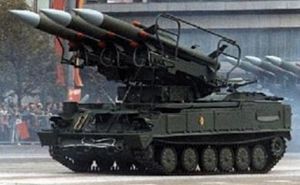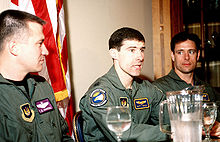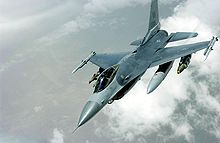- Mrkonjić Grad incident
-
Mrkonjić Grad incident Part of the Bosnian War 
SA-6 GainfulDate June 2, 1995 Location Mrkonjić Grad, Bosnia and Herzegovina Result Serb victory, but the American pilot that was shot down survived and was rescued six days later. Belligerents 
RV i PVO VRS
USAFStrength 2K12 Kub missile batteries Later
A large group of infantry
2 F-16 Fighting Falcons Later
Two CH-53 Stallions
51 Search & Rescue Marines
Casualties and losses none 1 F-16C shot down 1 CH-53 heavily damaged
1 Marine wounded, but later healed
The Mrkonjić Grad incident was the shooting down of a United States Air Force (USAF) F-16C by a Bosnian Serb Army SA-6 surface-to-air missile near Mrkonjić Grad, Bosnia and Herzegovina, on June 2, 1995. The American pilot, Scott O'Grady, ejected safely and was rescued six days later, on June 8.[1]
Contents
NATO: Operation Deny Flight
The Bosnian War was an international armed conflict that took place in Bosnia and Herzegovina between April 1992 and December 1995. The North Atlantic Treaty Organization (NATO) after popular pressure had decided to intervene in the Bosnian War after allegations of war crimes against civilians were made by various media organizations. NATO military involvement primarily involved enforcement of a "No Fly Zone" code named Operation Deny Flight to discourage military aircraft from the Serbian Armed Forces from attacking Bosnian civilians and Bosniak and Croat forces.[2] As part of that operation, two F-16s from the 555th Fighter Squadron based at Aviano Air Base, Italy, were patrolling overhead on June 2.[3]
On the ground, a SA 6 Gainful surface-to-air missile system was readying its missiles for NATO aircraft. The Serbs had moved the mobile tracked missile battery and laid a trap. They switched on their missile radars sparingly, giving the F-16 pilots little warning. Waiting until it was directly overhead, where the aircraft's warning and countermeasures would be at its weakest, they fired two missiles skyward. In the cockpit, O'Grady's instruments alerted him that a missile was coming but, flying in clouds, he could not see it. The first missile exploded between the two aircraft. The second struck the F-16 piloted by O'Grady.[1] His wingman, Captain Bob Wright, saw O'Grady's plane burst into flames, breaking it in two. He did not see a parachute, but O'Grady survived as he ejected from the aircraft.[3]
O'Grady landed amidst a Serbian population that was assumed to be unfriendly and, within a minute, he had secured a 29-pound survival bag under his seat, ran, and hid. Rubbing dirt on his face, he hid face-down as Serbian forces came upon his parachute and ejection seat, at one point hitting the ground with their rifles in an effort to flush him out only feet from where he was hidden.[1]
During the next six days, he put to use the lessons learned during a 17 day Survival, Evasion, Resistance and Escape (SERE) training he had undertaken near his hometown of Spokane, WA. He ate leaves, grass, and bugs, and stored the little rainwater he could collect with a sponge in plastic bags.[4]
O'Grady waited to radio for help, as the US Air Force had taught him that downed pilots are often captured after calling for help too soon, giving away their position. On his fourth full day on the ground, he signaled his location using the small reserve of his radio's battery power each time he went on the air. Allied military planes conducting sorties in the Balkans had been picking up beeper snippets that they thought could be coming from O'Grady. Unfortunately, this extremely sensitive piece of information was inadvertently revealed by General Ronald Fogleman, the Air Force Chief of Staff, when the general told reporters at a promotion ceremony one Monday that monitors had detected "intermittent" transmissions.[5] A NATO official was quoted as saying "I was dumbfounded he said that... I mean, why not just announce to the bad guys, 'We think he's alive and kicking, and we hope we find him before you do'?"[3]
Rescue
Just after midnight June 8,[6] he spoke into the radio. An F-16 pilot from the 555th responded, and after confirming his identity, the rescue was set in motion. At 4:40, Admiral Leighton Smith, commander of NATO Southern Forces, called US Marine Colonel Martin Berndt aboard the USS Kearsarge with orders to "execute."[1]
Two CH-53 Sea Stallions with 51 Marines from the 24th Marine Expeditionary Force, lifted off the USS Kearsarge to rescue the pilot. The two helicopters were accompanied by two Marine AH-1W SuperCobra helicopter gunships and a pair of Marine AV-8B Harrier jump jets. These six aircraft had support from identical sets of replacement helicopters and jump jets as well as two Navy EA-6B Prowler electronic warfare planes, two Marine F/A-18D Hornets, a pair of anti-tank Air Force A-10 Warthogs and a NATO AWACS radar plane.[3]
At 6:35 a.m., the helicopters approached the area where O'Grady's signal beacon had been traced. The pilots saw bright yellow smoke coming from trees near a rocky pasture where O'Grady had set off a flare. The first Stallion, commanded by Major William Tarbutton, touched down and 20 Marines jumped off the aircraft and set up a defensive perimeter.[1] As the second Sea Stallion landed, a figure with a pistol who turned out to be the missing pilot appeared running towards the Marines and immediately went to the Sea Stallion.[7] As the side door opened, he was pulled in before the second 20 Marines poised to leave by the rear ramp could even move. They were called back to their seats, and those who had formed the defensive perimeter reboarded the other helicopter. After a quick head count, the Stallions took off. They had been on the ground no more than seven minutes.[3]
The Return
The Marines and their passenger were still flying low over Serb-held Bosnia, so the threat was not yet over. American aircraft detected a Serb missile radar along the Croatian coast, scanning for targets. An American plane recommended destroying the Serb radar, code-named Giraffe. The request was denied, partly out of concern that a strike could spark wider conflict.[6]
Minutes later, the Marines reported they were under fire. Two shoulder-held surface-to-air missiles had been launched at them but missed, as the helicopter pilots—flying 150 feet off the ground at 175 mph—jinked to evade them. Serb small arms pocked both helicopters; the Marines aboard heard the shells hit inside the fuselage.[3][6] One door gunner returned fire. One round hit some communication gear in the chopper and the bullet ended up against a Master Sergeant Angel Castro Jr.'s armor without injuring anyone. They were almost safe; At 7:15 AM local time, 30 minutes after picking up O'Grady, the rescuers reported "feet wet," meaning they were over water.[3][6] O'Grady was back aboard Kearsarge at 7:30.[5] All of the aircraft landed without incident.
In popular culture
The 2001 film Behind Enemy Lines starring Gene Hackman and Owen Wilson is loosely based on this event. O'Grady sued 20th Century Fox for making a film he believes was made about him without seeking his permission. He took action over the documentary, Behind Enemy Lines: The Scott O'Grady Story, which was made by the BBC, and later purchased and edited by Discovery Communications, which owns the Discovery Channel. The documentary was screened several times on the Discovery Channel, and O'Grady accused Fox of using it to promote the film. O'Grady took offense at the portrayal of 'his' character in Behind Enemy Lines "as a pilot who disobeys orders and swears".[8] The suits were settled in 2004.[9] A Texas court ruled against O'Grady and in favor of Discovery Communications stating in effect that the events in a persons life is not the same thing as one's likeness or image. [10]
The incident was later depicted on the documentary television program Situation Critical in episode #5 "Downed Pilot". It was also covered in "Escape! – Escape From Bosnia: The Scott O'Grady Story" on the History Channel.
O'Grady authored two books, one with Michael French detailing his experiences of being shot down over Bosnia and his eventual rescue — Basher Five-Two: The True Story of F-16 Fighter Pilot Captain Scott O'Grady.[11] He later wrote a book concerning the spiritual effects from his experience in Return with Honor with Jeff Coplon.[12] Another book has also been written: "Good to Go": The Rescue of Capt. Scott O'Grady, USAF, from Bosnia by Mary Pat Kelly.[13]
See also
- Banja Luka incident in which Wright, the aforementioned lead pilot on O'Grady's mission, shot down three "Jastrebs".
References
- ^ a b c d e Bruce B. Auster (19 June 1995). "One Amazing Kid - Capt. Scott O' Grady escapes from Bosnia-Herzegovina". U.S. News & World Report. Archived from the original on 8 June 2011. http://www.webcitation.org/5zHdif1Rp.
- ^ "Operation Deny Flight". AFSOUTH. 18 July 2003. Archived from the original on 8 June 2011. http://www.webcitation.org/5zHdEB6Zg.
- ^ a b c d e f g Kevin Fedarko, Mark Thompson, Edward Barnes, Ann Blackman, Greg Burke, Dan Cray, Douglas Waller (19 June 1995). "Rescuing Scott O'Grady: All For One". Time Magazine. Archived from the original on 8 June 2011. http://www.webcitation.org/5zHdPrWZu.
- ^ Basher Five-Two: The True Story of F-16 Fighter Pilot Captain Scott O'Grady By Scott O'Grady, Michael French
- ^ a b "DoD News Briefing: Admiral William Owens, Vice Chairman, Joint Chiefs of Staff". U.S. Department of Defense. 8 June 1995. Archived from the original on 8 June 2011. http://www.webcitation.org/5zHdX96Ry.
- ^ a b c d Evan Thomas (19 June 1995). Newsweek. Archived from the original on 8 June 2011. http://www.webcitation.org/5zHdU5lyv.
- ^ Francis X. Clines (9 June 1995). "Conflict in the Balkans: The Rescue; Downed U.S. Pilot Rescued in Bosnia in Daring Raid". New York Times. Archived from the original on 8 June 2011. http://www.webcitation.org/5zHdXbv5L.
- ^ "Pilot sues over Bosnian escape film". BBC News. 20 August 2002. http://news.bbc.co.uk/2/hi/entertainment/2205560.stm. Retrieved 8 June 2011.
- ^ Sarah Hall (21 January 2004). ""Behind Enemy Lines" Suit Settled". Archived from the original on 8 June 2011. http://www.webcitation.org/5zHeSRm6x.
- ^ TEXAS INTELLECTUAL PROPERTY LAW JOURNAL http://www.pattersonsheridan.com/images/uploads/TIPLJ-18-1-4-Jaasma-AuthorPDF.pdf
- ^ Basher Five-Two: The True Story of F-16 Fighter Pilot Captain Scott O'Grady Publisher: Yearling; Reprint edition (July 6, 1998)Language: English ISBN 978-0440413134 ASIN: 0440413133
- ^ Return with Honor Publisher: HarperTorch (August 23, 1996) Language: English ISBN 978-0061011474
- ^ "Good to Go": The Rescue of Capt. Scott O'Grady, USAF, from Bosnia by Mary Pat Kelly (Hardcover - Apr 1996) - Illustrated Publisher: Delacorte Books for Young Readers; 1st Printing edition (November 13, 2001) Language: English ISBN 978-0385729994
External links
Coordinates: 44°24′12.36″N 17°2′52.46″E / 44.4034333°N 17.0479056°E
Bosnian War Timeline 19911992 Serbian Republic of Bosnia and Herzegovina ·
Serbian Republic of Bosnia and Herzegovina ·  Republic of Bosnia and Herzegovina · Siege of Sarajevo · Siege of Bihać · Graz agreement · Croat–Bosniak War · Operation Vrbas '92 · Operation Corridor1993Kravica attack · Siege of Gornji Vakuf · Siege of Mostar · Operation Neretva '93 ·
Republic of Bosnia and Herzegovina · Siege of Sarajevo · Siege of Bihać · Graz agreement · Croat–Bosniak War · Operation Vrbas '92 · Operation Corridor1993Kravica attack · Siege of Gornji Vakuf · Siege of Mostar · Operation Neretva '93 · Autonomous Province of Western Bosnia · Operation Deny Flight19941995
Autonomous Province of Western Bosnia · Operation Deny Flight19941995War Crimes Ethnic cleansingAhatovići · Ahmići · Bijeljina · Biljani · Čemerno · Doboj · Dobrinja · Doljani · Duša · Foča · Glogova · Grabovica · Kiseljak · Korićani Cliffs · Kravica · Lašva Valley · Makljen · Markale · Mokronoge · Prijedor · Prozor · Raštani · Srebrenica · Stolac · Stupni Do · Štrpci · Tuzla · Višegrad (Barimo, Bosanska Jagodina, Paklenik, Sjeverin) · Vlasenica · Vrbanja · Zaklopača · ZvornikCampsCasesCategories:- Conflicts in 1995
- Bosnian War
- History of Bosnia and Herzegovina
- History of Republika Srpska
- Military history of the United States (1900–1999)
- 1995 in Bosnia and Herzegovina
- United States Marine Corps in the 20th century
- Aircraft shootdowns
- Combat incidents
- Battles and conflicts without fatalities
Wikimedia Foundation. 2010.


